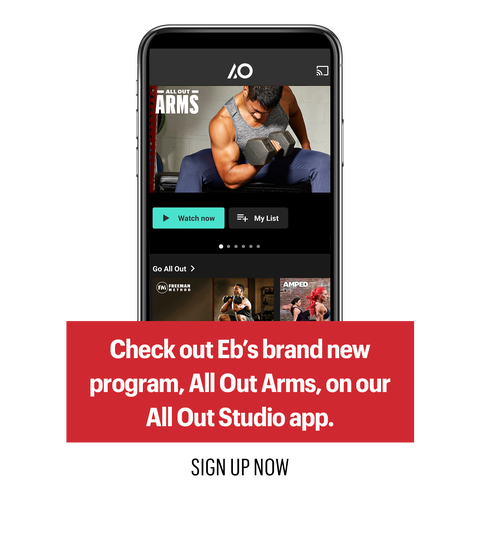The upright row is a well-known shoulder exercise, a popular movement among bodybuilders and CrossFitters that can pack size and strength onto your rear delts. It’s also an exercise that can cause plenty of shoulder pain and discomfort and prevent you from reaching your full shoulder development potential.
That’s partly because the way most people do upright rows (and the way you may have been taught to do the move) isn’t wrong, or smart. Standard upright row form doesn’t take into consideration the way the shoulder joint is built to move. That’s compounded even further by the imbalances of everyday life today, where you frequently find yourself hunched over your desk, or your phone, or your laptop.
None of this means you should never, ever do upright rows, but it does mean you need to adjust how you approach them. And MH fitness director Ebenezer Samuel, C.S.C.S., creator of the All Out Arms program, knows exactly how.
“Upright rows can be done,” he says, “but there’s a much smarter way to execute them than what you’ve been taught. It’s all about remembering what you’re aiming to develop with the upright row, and about keeping in mind how the shoulder works.”
How Upright Rows Lead to Injury
The classic upright row has you standing with an EZ curl bar or a barbell held at your hips, hands relatively close (sometimes even at the center of the bar). From there, you’re often taught to pull the bar up to your neck, driving your elbows as high as possible.
That’s an instantly problematic position for your shoulders. The moment your elbows get higher than your shoulders, the bar pulls your shoulder joint is in something called “internal rotation.” This is especially true if you’re going heavy on your upright rows. Suddenly, the head of your humerus (or upper arm bone) starts closing the space between other bones in the area, and all the bones in your shoulder become prone to rubbing against rotator cuff tendons and soft tissue.
Over time, all of this can lead to injury. And it’s not even developing your shoulders all that much, either. One of the key functions of your rear delts is to pull your upper arms behind your torso, but because of the rigidity of the bar, your elbows never actually wind up behind your torso. “You’re lifting heavy,” says Samuel, “but not pushing for the strength or muscle you really want.”
The Better Way to Upright Row
To get the benefits of upright rows without the injury concerns, you should make three key adjustments. But even then, tread cautiously. “There are plenty of other rear delt exercises out there,” says Samuel. “And really, if you’re attacking standard rows on back day, you may not even need upright rows in your program.”
If you want the move in your program, though, tweak your form to attack both the function of the muscles you’re aiming to hit, and to keep yourself out of internal rotation.
Ditch the Bar
Forget barbells and EZ curl bars for upright rows; neither implement lets your shoulders move with the freedom they need. Instead, grab a pair of dumbbells. Suddenly, your arms will be freed from their close-grip setup. “This means you can start with tighter posture,” says Samuel. “Start standing, with your abs and glutes tight, and squeeze your shoulder blades too. The dumbbells will let you do this.”
Hold the dumbbells naturally. And yes, dumbbells (and not kettlebells) are key to making this work. Having the loads on either side of your hand (instead of below your hand, as is the case with a kettlebell) will help keep you out of internal rotation.
Don’t Pull So High
Instead of pull upwards so your elbows wind up higher than your shoulders, stop a hair below shoulder-height, says Samuel. This will keep your shoulders from shifting into internal rotation, and it’ll do more than that, too: It’ll keep tension on your medial deltoid.
“Once elbow height exceeds shoulder height, you’re very often taking tension off your shoulders,” says Samuel, “and shifting it into your traps. By stopping with your elbows slightly below your shoulders, you’re essentially mimicking a lateral raise, with a shorter lever.”
Yes, that means you’ll need to use lighter weights, but, truth be told, you shouldn’t be pounding out ultra-heavy reps on upright rows, anyway. By using a lighter weight, you’ll be able to keep your shoulders from shifting into internal rotation.
After You Pull Up, Pull Back
Instead of thinking of upright rows as pulling straight up, think of them as a two-part motion. Pull up so your elbows are slightly lower than your shoulders, and then pull back, as if doing a wide-grip bent-over barbell row. “Aim to get your elbows behind your torso and squeeze your shoulder blades,” says Samuel. “If you’re here for rear delt development, take advantage of this moment. It’s in this moment that your rear delts must work in concert with a lot of your shoulder stabilizing muscles.”
Adding this motion in reinforces the upright row as a rear delt developer, but don’t expect it to be easy. Think of rotating your wrists upwards slightly (as an added bonus, this insures your external rotators fire), and then pulling back with slight body English. It won’t be easy, says Samuel, but it will be beneficial.
It’ll all add up to a better, safer, more shoulder-sustainable upright row. Yes, you’ll be working with lighter weights, but you’ll still get plenty of muscle burn. Think of doing 3 sets of 8 to 12 reps on shoulder day, as a finishing move for shoulders, after you’ve done more traditional moves at higher weights.
For more tips and routines from Samuel, check out our full slate of Eb and Swole workouts. Want a safe arm program that’ll build muscle? Then All Out Arms is for you.
Source: Read Full Article

